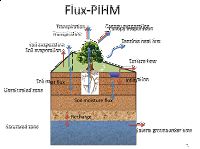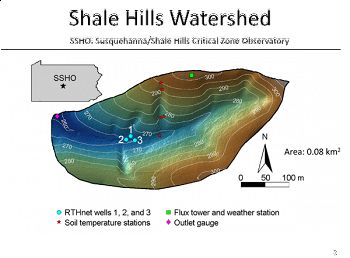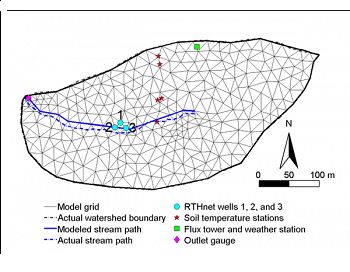Flux-PIHM
Flux-PIHM
Flux PIHM is a fully-coupled land surface hydrologic model with improved land-atmosphere interactions.
Model Category: Conceptual | Numerical
Image: Schematic of Flux-PIHM model structure on an individual TIN cell.
-
Shale Hills, INVESTIGATOR
-
Shale Hills, INVESTIGATOR
-
Shale Hills, INVESTIGATOR
-
Shale Hills, GRAD STUDENT
Flux PIHM is a fully-coupled land surface hydrologic model. It is developed by incorporating a land-surface scheme into the Penn State Integrated Hydrologic Model (PIHM). The land-surface scheme is mainly adapted from the Noah LSM.
In Flux-PIHM, the surface energy balance scheme completely replaces the original evapotranspiration formulation in PIHM. The land surface and hydrologic components are coupled by exchanging water table depth, soil moisture, infiltration rate, recharge rate, net precipitation rate, and evapotranspiration rate between each other. At each time step, the hydrologic component provides the land surface component with water table depth, infiltration rate, recharge rate, and integrated soil water storage over soil column. The soil layers below water table are set to saturation. Soil moisture equations are applied to the soil layers above the water table. Infiltration rate and recharge rate calculated by the hydrologic component are used as top and bottom boundary conditions for soil moisture transport. The volumetric soil moisture contents simulated by land surface component are rescaled using the integrated soil water storage provided by PIHM to guarantee mass conservation. The land surface component then starts surface energy balance simulation and provides the hydrologic component with net precipitation rate and evapotranspiration rate.
Because PIHM is capable of simulating lateral groundwater flow that explicitly resolves low-order channel networks, Flux-PIHM is able to represent land surface heterogeneities caused by topography and capture time scales that are generally missing in current land surface models. At the same time, the robust land surface scheme provides accurate sensible heat flux and evapotranspiration simulations at all scales in the watershed or river network. The coupled hydrologic and land surface schemes guarantee mass conservation at the subsurface as well as the land surface, conserve energy balance at land surface, and provide physical constraints to surface heat fluxes and subsurface water movement.
Calibration data includes discharge, water table depth, soil moisture content, sensible and latent heat fluxes during the period June and July 2009.
Flux-PIHM has been implemented at the Shale Hills watershed (0.08 km2) in central Pennsylvania. Multi-state observations of discharge, water table depth, soil moisture, soil temperature, and sensible and latent heat fluxes in June and July 2009 are used to manually calibrate Flux-PIHM. Model predictions from 1 March to 1 December 2009 are evaluated. Both hydrologic predictions and SEB predictions show good agreement with observations. The discharge prediction is comparable or superior to a state-of-the-art conceptual model implemented at similar watersheds. Comparisons of model predictions between Flux-PIHM and the original PIHM show that the inclusion of the complex SEB simulation only brings slight improvement in hourly model discharge predictions. Flux-PIHM improves the evapotranspiration prediction at hourly scale, the prediction of total runoff (discharge), and the predictions of some peak discharge events, especially after extended dry periods.
Flux-PIHM also serves as the conceptual framework for the Weather/Climate component of Critical Zone processes for the SSHCZO team.
Flux-PIHM has been implemented at the Shale Hills watershed (0.08 km2) in central Pennsylvania.
Calibration data includes discharge, water table depth, soil moisture content, sensible and latent heat fluxes during the period June and July 2009.
Publications
2014
Evaluation of the parameter sensitivity of a coupled land surface hydrologic model. Shi, Y., K. J. Davis, F. Zhang, and C. J. Duffy (2014): Journal of Hydrometeorology, 15:279–299
2013
Development of a Coupled Land Surface Hydrologic Model and Evaluation at a Critical Zone Observatory. Shi, Y., K. J. Davis, C. J. Duffy, and X. Yu (2013): Journal of Hydrometeorology, 14, 1401—1420
2012
Development of a land surface hydrologic modeling and data assimilation system for the study of subsurface-land surface interaction. Shi, Y. (2012): Doctor of Philosophy, Meteorology, The Pennsylvania State University, p. 214.
Explore Further







